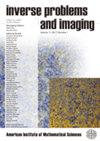贝叶斯反问题的非局部tv -高斯先验及其在有限CT重建中的应用
IF 1.5
4区 数学
Q2 MATHEMATICS, APPLIED
引用次数: 9
摘要
贝叶斯推理方法由于其估计的不确定性表征能力,在反问题中得到了广泛的应用。未知事物的先验分布在贝叶斯推理中起着至关重要的作用,良好的先验分布可以显著提高推理结果。本文提出了一种结合非局部全变分正则化(NLTV)和高斯分布的混合先验分布,即NLTG先验。这种混合先验的优势是双重的。提出的先验模型通过NLTV同时呈现图像的纹理和几何结构。高斯参考度量还提供了从参考图像中合并结构信息的灵活性。建立了混合先验的一些理论性质。我们将提出的先验方法应用于有限的断层扫描重建问题,该问题由于严重的数据缺失而变得困难。通过两种有效的方法计算最大后验估计和条件平均估计,并通过数值实验验证了所提出的NLTG先验算法的优越性和可行性。本文章由计算机程序翻译,如有差异,请以英文原文为准。
Nonlocal TV-Gaussian prior for Bayesian inverse problems with applications to limited CT reconstruction
Bayesian inference methods have been widely applied in inverse problems due to the ability of uncertainty characterization of the estimation. The prior distribution of the unknown plays an essential role in the Bayesian inference, and a good prior distribution can significantly improve the inference results. In this paper, we propose a hybrid prior distribution on combining the nonlocal total variation regularization (NLTV) and the Gaussian distribution, namely NLTG prior. The advantage of this hybrid prior is two-fold. The proposed prior models both texture and geometric structures present in images through the NLTV. The Gaussian reference measure also provides a flexibility of incorporating structure information from a reference image. Some theoretical properties are established for the hybrid prior. We apply the proposed prior to limited tomography reconstruction problem that is difficult due to severe data missing. Both maximum a posteriori and conditional mean estimates are computed through two efficient methods and the numerical experiments validate the advantages and feasibility of the proposed NLTG prior.
求助全文
通过发布文献求助,成功后即可免费获取论文全文。
去求助
来源期刊

Inverse Problems and Imaging
数学-物理:数学物理
CiteScore
2.50
自引率
0.00%
发文量
55
审稿时长
>12 weeks
期刊介绍:
Inverse Problems and Imaging publishes research articles of the highest quality that employ innovative mathematical and modeling techniques to study inverse and imaging problems arising in engineering and other sciences. Every published paper has a strong mathematical orientation employing methods from such areas as control theory, discrete mathematics, differential geometry, harmonic analysis, functional analysis, integral geometry, mathematical physics, numerical analysis, optimization, partial differential equations, and stochastic and statistical methods. The field of applications includes medical and other imaging, nondestructive testing, geophysical prospection and remote sensing as well as image analysis and image processing.
This journal is committed to recording important new results in its field and will maintain the highest standards of innovation and quality. To be published in this journal, a paper must be correct, novel, nontrivial and of interest to a substantial number of researchers and readers.
 求助内容:
求助内容: 应助结果提醒方式:
应助结果提醒方式:


